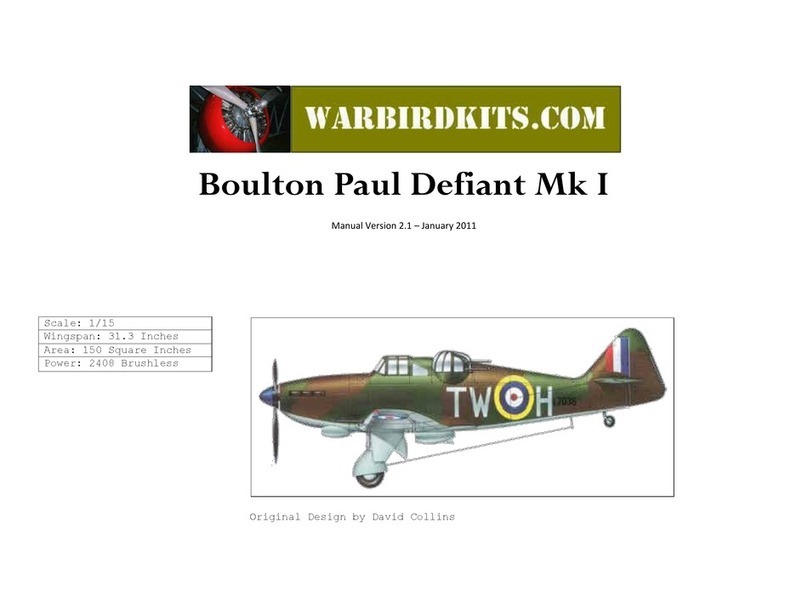Assembly Manual for IAR-80 (Version 1.3)
Copyright 2012 Thomas A. Jacoby and WarbirdKits.com 3
with another board, books or what have you. Keep the
weight on the skin until it is completely dry.
When the skin is dry, remove the masking tape. Lay a
skin on a flat board with the outer surface up, and sand
it smooth with 120 grit paper on a long sanding block.
Be sure to keep your sanding motion at a 45 degree
angle to the joints and wood grain. Clean the skin with
a tack rag.
Note – it should not be necessary to sand the inner
surfaces of the wing skin. Just be sure to remove any
excess glue.
Follow the same steps to assemble two wing top skins,
using 1/16” x 4” x 36” balsa sheets.
Lay a bottom skin on a top skin. Trace the shape of the
bottom skin onto the top skin, adding a 1/4” margin at
the trailing edge. Cut out the top skin.
Wing Panels
Pin a lower wing skin to your building board. The lower
skins are the ones with the rib and spar positions
etched into them.
Glue the ribs and main spar to the bottom sheet. Note
that the spar is notched at the dihedral angle for root
rib W1. To maintain an accurate Clark Y airfoil, moisten
the leading edge of the sheeting and pack it up so that
it follows the curve on the bottoms of the ribs.
Glue the 3/8” x 1/2” leading edge strip in place against
the front of the wing skin. Note that the leading edge
strip sits on your building board, not on the wing skin.
Glue the aileron spar to the bottom sheet and ribs.
Glue the aileron leading edge to the bottom sheet,
about 1/32” aft of the aileron spar. DO NOT glue the
aileron leading edge to the aileron spar.
Glue the stub ribs to the rear of the aileron leading
edge and the bottom sheet.
Cut three aileron crank bearings from 3/32” aluminum
tube. Make them about 1/2” long.
Make an aileron crank from 1/16” music wire and the
three bearings.
Trim a slot in the aileron leading edge for the aileron
crank. Glue the aileron crank in place, with glue on the
bearings where they pass through ribs W2, W3 and
W4.
Use scrap balsa to make a bearing block for the aileron
crank. DO NOT glue the music wire crank to the
bottom skin or to the bearing block.
Glue scrap 1/16” or 1/8” balsa reinforcements to the
outside rear portion of rib W1. Using a sharp #11
blade, cut a slot in root rib W1 for the wing bolt, but
don’t cut the reinforcements. The center of the slot
should be about 1/2” forward of the trailing edge. Notch
the bottom skin so that you can find the bolt hole later.
Using a long sanding block and fine grit sandpaper,
sand the assembled wing panel to prepare it for the top
skin. Sand the airfoil angle into the trailing edge, so
that the trailing edge is about 1/32” thick.
Put the washout jig in place under the wing trailing
edge. The thick end of the jig goes at the wingtip. Pin
the wing down.


























